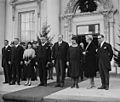Pascual Ortiz Rubio facts for kids
Quick facts for kids
Pascual Ortiz Rubio
|
|
|---|---|

Rubio Ortiz Pascual, 1930
|
|
| 49th President of Mexico | |
| In office 5 February 1930 – 4 September 1932 |
|
| Preceded by | Emilio Portes Gil |
| Succeeded by | Abelardo L. Rodríguez |
| Member of the Chamber of Deputies for Michoacán's 2nd district |
|
| In office 16 September 1912 – 10 October 1913 |
|
| Preceded by | Ricardo García Granados |
| Personal details | |
| Born | 10 March 1877 Morelia, Michoacán |
| Died | 4 November 1963 (aged 86) Mexico City |
| Political party | National Revolutionary Party |
| Spouse |
Josefina Ortiz
(m. 1920) |
Pascual Ortiz Rubio (born March 10, 1877 – died November 4, 1963) was an important figure in Mexican history. He served as the President of Mexico from 1930 to 1932. His time as president was part of a period called the Maximato. During this time, former president Plutarco Elías Calles still held a lot of power behind the scenes. Ortiz Rubio eventually resigned because he felt Calles was controlling too much of the government.
Contents
Early Life and Education
Pascual Ortiz Rubio was born in Morelia, a city in Michoacán, Mexico. His father was a lawyer and also owned land. Pascual studied engineering at the Colegio de San Nicolás in Morelia.
Even as a student, he was interested in politics. He did not agree with President Porfirio Díaz running for re-election in 1896.
Joining the Revolution
When the Mexican Revolution began in 1910, Mexico was changing quickly. In 1911, Francisco I. Madero was elected president. Ortiz Rubio was then chosen to represent Michoacán in the federal legislature.
However, in 1913, General Victoriano Huerta took power. He forced Madero to resign and then had him killed. Huerta also put Ortiz Rubio in jail. But Huerta's rule did not last long. In 1914, he was removed from power.
Ortiz Rubio then joined the Constitutionalist Army, led by Venustiano Carranza. He started as a colonel and rose to the rank of brigadier general. This group eventually won against other revolutionary groups.
Political Career
Early Government Roles
After the revolution, Ortiz Rubio held several important jobs. He was the Governor of Michoacán from 1917 to 1920. Then, he became the secretary of communications from 1920 to 1921. He worked under generals Adolfo de la Huerta and Álvaro Obregón. These generals, along with Plutarco Elías Calles, were very powerful in Mexican politics during the 1920s.
When Calles became president in 1924, Ortiz Rubio was chosen to be Mexico's ambassador. He served as ambassador first in Germany and then in Brazil.
Becoming President (1929–1932)
The time when Ortiz Rubio was president is often seen as the peak of former President Calles's power. Calles was known as the jefe máximo, or "supreme leader." Many people saw Ortiz Rubio as a "puppet president" because Calles seemed to be in charge.
The 1929 Election
In 1928, the president-elect, Álvaro Obregón, was assassinated. This created a big power gap. Calles could not be president again right away. So, he created a new political party called the Partido Nacional Revolucionario (PNR). This party helped Calles keep control over who became president.
Emilio Portes Gil was the temporary president after Obregón's death. New elections were planned for 1929. Calles chose Ortiz Rubio to be the PNR's candidate for president. Ortiz Rubio ran against José Vasconcelos, who had been Obregón's Secretary of Public Education. Vasconcelos was known for fighting against corruption and Calles's strong rule.
Ortiz Rubio did not have his own strong group of supporters. This meant he relied heavily on Calles. Because of this, he was seen as a less effective leader as president. The official results of the 1929 elections showed Ortiz Rubio winning by a large margin. However, some people at the time believed that Vasconcelos actually won the election.
Key Events as President
During his time as president, Ortiz Rubio helped pass a new labor law. He also opened the zoo in Chapultepec Park in Mexico City.
Resignation
Ortiz Rubio felt that former President Calles was interfering too much in his presidency. He also had been seriously shaken by an attempt on his life right at the start of his term. Because of these reasons, he decided to resign from the presidency on September 4, 1932. He famously said he resigned "with my hands clean of blood or money." Later, in his own book, he described Calles's rule as a "thinly veiled dictatorship."
After his resignation, Abelardo L. Rodríguez became the new president. He was another general who had been supported by Calles. Rodríguez served for the remaining two years of the six-year term.
Later Life
After resigning, Ortiz Rubio moved to the United States for a while. He returned to Mexico in 1935. This was after Lázaro Cárdenas, who was also from Michoacán, became president in 1934.
In 1942, President Manuel Ávila Camacho invited all former presidents of Mexico to a public event. This was a way to show unity in the country. Ortiz Rubio attended, along with Emilio Portes Gil, Abelardo Rodríguez, Lázaro Cárdenas, and Plutarco Elías Calles.
Ortiz Rubio also wrote a book about his life in 1963.
Gallery
See also
 In Spanish: Pascual Ortiz Rubio para niños
In Spanish: Pascual Ortiz Rubio para niños





